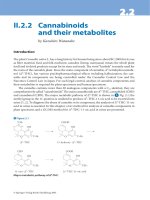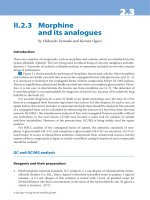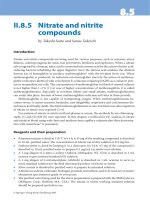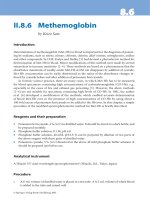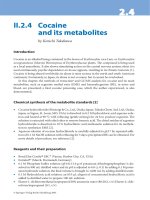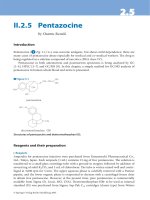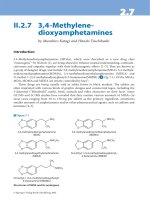Drugs and Poisons in Humans - A Handbook of Practical Analysis (Part 21)
Bạn đang xem bản rút gọn của tài liệu. Xem và tải ngay bản đầy đủ của tài liệu tại đây (341.94 KB, 12 trang )
2.32.3
© Springer-Verlag Berlin Heidelberg 2005
II.2.3 Morphine
and its analogues
by Hideyuki Yamada and Kazuta Oguri
Introduction
ere are a number of compounds, such as morphine and codeine, which are classi ed into the
opium alkaloids ( opiates). ey are being used as ethical drugs of narcotic analgesics and anti-
tussives; 1 % powder of codeine or dihydrocodeine is commonly included in over-the-counter
drugs of antitussives.
> Figure 3.1 shows metabolic pathways of morphine, heroin and codeine. Since morphine
and codeine are nally excreted into urine in the conjugated forms with glucuronic acid [1–3],
it is necessary to hydrolyze the conjugated forms of these compounds before GC/MS analysis.
Heroin is rapidly deacetylated and nally excreted into urine as morphine glucuronides. ere-
fore, it is not easy to discriminate the heroin use from morphine use [4, 5]. e detection of
6-acetylmorphine is recommendable for diagnosis of heroin use, because of its relatively long
half-life in the body [4].
For accurate diagnosis of a cause of death in an opiate poisoning case, the ratio of a free
form to a conjugated form becomes important (see section 4 of this chapter). In such a case, an
opiate before (free form) and a er (a total amount) hydrolysis should be analyzed. e amount
of a conjugated form can be calculated by subtracting the amount of a free form from the total
amount. By HPLC, the simultaneous analysis of free and conjugated forms is possible without
any hydrolysis; in the near future, LC/MS may become a main tool for analysis of opiates
and their metabolites. However, at the present time, GC/MS is being widely used for opiate
analysis.
For HPLC analysis of the conjugated forms of opiates, the authentic standards of mor-
phine-3-glucuronide (M-3-G) and morphine-6-glucuronide (M-6-G) are necessary. In U.S.A.
and Europe, it is easy to obtain these authentic compounds from commercial sources, but the
import of these compounds to Japan is strictly controlled; easing of import of such compounds
should be realized.
GC and GC/MS analysis
Reagents and their preparation
• Ethylmorphine (internal standard, IS)
a
solution: a 1-mg aliquot of ethylmorphine hydro-
chloride (Sankyo Co., Ltd., Tokyo, Japan) is dissolved in puri ed water to prepare 1 mg/mL
solution. A 0.1-mL aliquot of this solution is mixed with 1.9 mL of puri ed water for
20-fold dilution (the nal concentration in the form of the hydrochloride salt: 50 µg/mL),
which is stored at –20 °C.
196 Morphine and its analogues
Main metabolic pathways of morphine, heroin and codeine. The thick and thin arrows show the main and minor metabolic pathways, respectively.
⊡ Figure 3.1
197
• Standard solutions of morphine for a calibration curve (2, 6 and 20 µg/mL): a 1-mg aliquot
of morphine hydrochloride (Shionogi & Co, Ltd., Osaka, Japan and other manufacturers)
is dissolved in puri ed water to prepare 1 mg/mL solution; 0.1 mL of this solution is mixed
with 4.9 mL puri ed water for 50-fold dilution (20 µg/mL). e latter solution is diluted
3.33-fold and 10-fold to prepare 6 and 2 µg/mL solutions, respectively, which are also
stored at –20 °C. For preparing the standard solutions to be used for a calibration curve of
6-acetylmorphine hydrochloride or codeine phosphate (Shionogi & Co.), the same dilution
procedure is followed. 6-Acetylmorphine hydrochloride can be synthesized by the method
previously reported [6].
• 5 M NaOH solution (100 mL): a 20-g aliquot of NaOH is dissolved in about 70 mL puri ed
water in a 100-mL volume glass beaker with stirring in an ice bath. A er the temperature
of the solution is cooled to room temperature, it is transferred to a 100 mL-volume volu-
metric ask together with the water solution which has been used for washing the above
glass beaker, and the volume is adjusted to 100 mL exactly. e solution is kept at room
temperature; it is essential to seal the ask airtightly, because CO
2
in atmospheric air can be
absorbed into the NaOH solution to yield NaHCO
3
, resulting in the decrease of titer of the
solution.
• 5 M NH
4
Cl/NH
3
bu er solution (pH 9, about 200 mL): a 23.7-mL volume of 28 % ammo-
nia water solution is dissolved in puri ed water to prepare 250 mL solution (5 M NH
3
solu-
tion). A 13.4-g aliquot of NH
4
Cl is dissolved in puri ed water to prepare 50 mL solution
(5 M NH
4
Cl solution). An appropriate amount of 5 M NH
3
solution is mixed with the 5 M
NH
4
Cl solution to adjust the pH to 9.0. e bu er can be stored at room temperature.
• 10 M KOH solution saturated with KHCO
3
(100 mL): a 56-g aliquot of KOH is dissolved in
about 70 mL puri ed water in a 100-mL volume glass beaker with stirring in an ice bath.
e volume of the solution is adjusted to about 85 mL with puri ed water and le until
being cooled to room temperature. e KHCO
3
powder is added to the NaOH solution
until its saturation with stirring (about 30 g necessary). Upon saturation, the volume of the
solution becomes to be about 100 mL. is can be used for experiments and is preservable
at room temperature.
• Pretreatment of a solid-phase extraction cartridge (Bond Elut Certify)
b
: a 2-mL volume
of methanol and 2 mL puri ed water are passed through a Bond Elut Certify cartridge (Var-
ian, Harbor City, CA, USA) just before use. For a new cartridge, each solution can ow by
natural pressure through it without any aspiration. When the ow stops, it is aspirated for a
moment; then the methanol or water can ow through it only by gravity. e puri ed water
should not be passed through the cartridge completely; the cartridge should not be dried.
e water ow should be stopped, when the water volume in the reservoir becomes small.
Analytical conditions
GC column: DB-1 (15 m × 0.25 mm i. d., lm thickness 0.25 µm, J & W Scienti c, Folsom, CA,
USA).
GC/MS conditions; instrument: an HP5890 GC-HP 5989A MS Engine (Agilent Technolo-
gies, Palo Alto, CA, USA); column (oven) temperature: 200 °C (0.5 min) →5 °C/min →260 °C
(3 min); injection temperature: 200 °C; injection volume: 1 µL (splitless mode); carrier gas: He;
ow pressure: 6 psi; ionization mode: EI; electron energy: 70 eV.
GC and GC/MS analysis
198 Morphine and its analogues
Procedures
Two extraction methods, the liquid-liquid extraction and the solid-phase extraction, are avail-
able; the latter gives cleaner extracts for GC and GC/MS analysis.
i. Liquid-liquid extraction
i. A 2-mL volume of urine
c
and 1.5 mL of concentrated hydrochloric acid are placed in a
50-mL volume glass centrifuge tube with a ground-in stopper, and heated at 100 °C for
30 min in a water bath to hydrolyze the conjugated forms of a target compound. e water
level of the water bath should be slightly above the surface level of the hydrolysis solution
in the tube. As a blank test, 2 mL urine obtained from a healthy subject is also treated as
above. For quantitative experiments, in addition, a 0.1-mL volume each of solutions at
three concentrations of an opiate (2.6 and 20 µg/mL) is added to 2 mL each of the blank
urine; these samples are also processed in the same way as above.
ii. A er cooling to room temperature, 0.1 mL of the IS solution is added to the hydrolyzed
solution. A 3-mL volume of 5 M NaOH is added to the solution for neutralization, followed
by the addition of 4 mL of 5 M NH
4
Cl/NH
3
bu er solution (pH 9). e nal pH of the solu-
tion should be checked with a test paper (Whatman, type CF); if the pH of the solution shi s
from 9, it should be readjusted to pH 9.0 by adding the above ammonium bu er solution.
iii. e above solution is extracted with 15 mL of chloroform/ isopropanol (9:1, v/v) by shaking.
iv. A er centrifugation at 3,000 rpm for 5 min, the organic (lower) layer is carefully trans-
ferred to another 50-mL volume glass centrifuge tube of the same type with a pipette, fol-
lowed by the addition of a su cient amount of anhydrous sodium sulfate (2–3 g), and
mixed well.
v. e organic solution is passed through folded lter paper to remove the dehydrator and
collected in a 10-mL volume glass centrifuge tube
d
with a ground-in stopper ( the shape of
the tube bottom preferably to be conical). e solution is evaporated to dryness under a
stream of nitrogen with warming the tube at 30–40 °C.
vi. e residue in the tube is mixed with 50 µL of N,O-bis(trimethylsilyl)acetamide ( BSA) rea-
gent
e
, capped airtightly and heated at 80 °C for 20 min; a 1-µL aliquot of the derivatized
solution is injected into GC or GC/MS.
vii.
For the unconjugated (free) forms of morphine, codeine and 6-acetylmorphine, the extraction
is made as follows
f
. A 2-mL volume of urine is diluted 2-fold with puri ed water and mixed
with 0.1 mL of the IS solution and 0.2 mL of 5 M NH
4
Cl/NH
3
bu er solution (pH 9). e pH
of the solution is con rmed to be 9 with a pH test paper; if not, an appropriate amount of the
ammonium bu er solution is added to it. e solution is extracted with 10 mL of chloroform/
isopropanol (9:1, v/v), and the following procedure is performed according to the above iv–vi
steps. e blank urine and calibration samples are also processed in the same way.
ii. Solid-phase extraction
i. e hydrolysis of urine is made according to the step i of the above section.
ii. e hydrolyzed solution is mixed with IS solution
a
, followed by a careful and gradual addi-
tion of 1.5 mL of 10 M KOH solution saturated with KHCO
3
(bubbling appears), mixed
with 3 mL of 2 M Tris-HCl bu er solution (pH 8.1) and stirred well. e pH of the nal
solution is com rmed to be 8–9 with a test paper. If not, the pH of the solution is adjusted
to 8–9 using the 10 M KOH solution saturated with KHCO
3
or 1 M HCl solution.
199
iii. e solution is poured into a Bond Elut Certify Cartridge to let the solution ow inside the
cartridge slowly taking more than 2 min to adsorb an opiate.
iv. e cartridge is washed with 2 mL each of puri ed water, 0.1 M acetate bu er solution
(pH 4) and methanol, and dried for 2 min by aspiration with a vacuum manifold, followed
by washing with 3 mL methanol and drying for 5 min again.
v. e target opiate is eluted, by passing 2 mL of dichloromethane/isopropanol/ammonia wa-
ter (80:20:2, v/v) through the cartridge, into a 10-mL volume glass centrifuge tube with a
ground-in stopper (the shape of the tube bottom preferably to be conical). e eluate is
evaporated to dryness under a stream of nitrogen with warming at 30–40 °C.
vi. e derivatization and injection into GC or GC/MS are made exactly in the same way as
that described in the step vi) of the above liquid-liquid extraction section.
vii. For the unconjugated (free) forms of morphine, codeine and 6-acetylmorphine, the extrac-
tion is made as follows. A 2-mL volume of urine is diluted 2-fold with puri ed water and
mixed with 0.1 mL of the IS solution and 0.2 mL of 2 M Tris-HCl bu er solution (pH 8.1).
e pH of the solution is con rmed to be 8–9; if not, an appropriate amount of the above
bu er solution is added to it. e blank urine and calibration samples are processed in the
same way. ese samples are equally treated according to the above steps iii–vi.
Assessment and some comments on the methods
Qualitative analysis is performed by nding a peak appearing at the same retention time
as that of the authentic standard a er trimethylsilyl (TMS) derivatization; it is also impor-
tant to con rm the absence of the corresponding peak in the blank specimen. e nal iden-
ti cation is made by comparing a mass spectrum obtained from a test specimen with that
obtained from the authentic standard. A total ion chromatogram (TIC) of the authentic com-
pounds is shown in
> Fig. 3.2; the mass spectra of the derivatized compounds are shown
in
> Fig. 3.3. Quantitation is performed by selected ion monitoring (SIM) using the peak
height or area ratio of a test compound to IS; the ratio is applied to a calibration curve, which
has been prepared in advance, to calculate the concentration of the test compound in a speci-
⊡ Figure 3.2
TIC of TMS derivatives of morphine and its analogues by GC/MS. Heroin is not derivatized.
The peak of the TMS derivative of ethylmorphine is not included in this chromatogram; but it is
eluted at 9.4 min under the same conditions.
GC and GC/MS analysis


